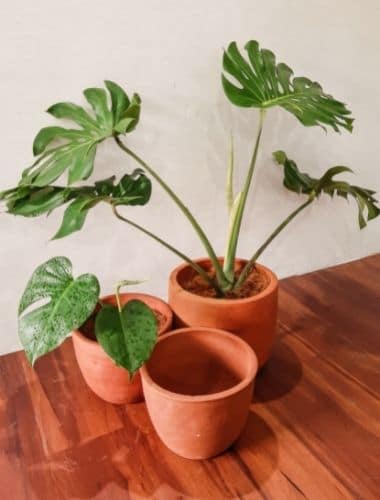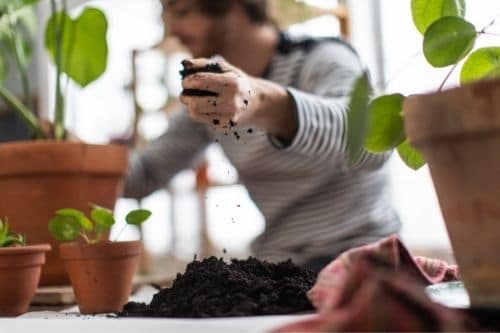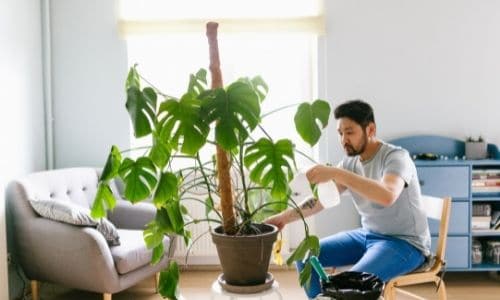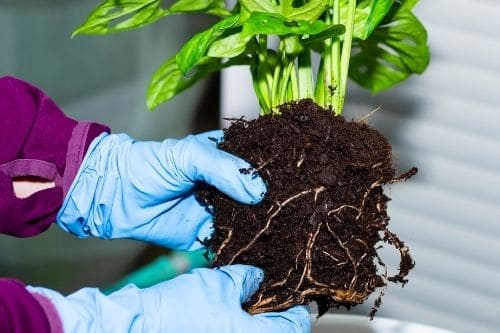If your Monstera’s roots are growing out of the bottom of the pot, you are probably aware that your plant needs some attention, but you might not know what to do.
If your Monstera has outgrown its pot, you will need to transplant it into a larger container, but this takes some care and skill, especially with a large plant that is using a moss pole for support. You will need the right mix of substrates and a suitable container before you start.
How Do I Know If My Monstera Needs Repotting?
Monstera plants can grow quickly when they are kept in the right conditions, and a young plant will need repotting quite often – sometimes as much as annually. This should usually be done in the spring or the summer, when your plant is growing, so you don’t accidentally disturb its dormancy period and cause stress.
You will know if your Monstera needs repotting if you can see roots coming out of the drainage holes at the bottom of the pot. Simply pick the plant up and inspect the drainage holes to check.
Other signs include roots coming out of the soil at the top of the pot, and water running through the pot too quickly. If your plant’s roots have filled the pot, the water will drain out of the bottom, rather than being soaked up by the soil.
Another clear indication that your plant is in a pot that’s too small is that the plant’s aerial roots grow very long. Its growth may also significantly slow down because it cannot expand its roots, and so cannot get any larger above the ground either.
How Big Should The Container Be?

Choosing the size of your Monstera’s next pot is important. You might think that giving it a huge pot is the way forward so it has lots of food and room to grow, but actually, a big pot can be a problem.
There are a few reasons for this. The most major one is that a large container puts your plant at greater risk of being overwatered because water can sit in the compost at the bottom of the pot and it’s hard to tell when the plant needs more to drink. The roots may stay wet, and bacteria and fungus can build up in the excess soil.
Another issue is that the nutrients in the soil may be depleted by the time your Monstera’s roots grow into it, which means it won’t get as much benefit from this food as it would if it was put into new compost.
Overall, it’s better to just go up one pot size whenever you repot your plant. If it is particularly cramped, a couple of pot sizes might be suitable, but don’t scale up enormously. It’s better to repot your plant every year or two than to grow it in a container that is far too big for it.
Make sure the container you choose has good drainage holes and looks nice – it will be your Monstera’s home for the next year or two, so don’t choose just any old pot!
What Kind Of Growing Medium Do I Need?
It’s important to get your Monstera into the right kind of soil, or it will not grow well. Drainage material is particularly important, although your plant does need plenty of compost too.

Most people use perlite in their Monsteras’ containers because this will help to absorb water and prevent your plant’s roots from getting too wet. You should also include some fine gravel or vermiculite, and organic matter, such as compost or worm castings.
These will feed your plant and ensure that it has the nutrients it needs to grow. If you don’t add at least some organic matter to the container, your Monstera will die.
What If I Recently Repotted My Monstera And It’s Rootbound Again?
If you have only repotted your plant in the last few months and it already seems to be tight in its pot, you might be unsure about what to do. Repotting your plant too frequently could cause stress and it’s a big chore.
You do not need to rush to repot the plant if you have recently given it a bigger pot; it will not mind being a little bit rootbound for a short period of time. You can leave it until the following spring. It’s quite common for repotted plants to have a growth spurt in response to the new compost and better conditions.
However, if you are really concerned about it, you can lift your Monstera out of the pot and add a little more soil underneath its roots, boosting it up a bit. This should give it some new medium to grow into and should keep it happy for a few more months.
If you do this, make sure you keep an eye on your plant to check it isn’t getting stressed by being cramped. While most Monsteras are happy in tight conditions, browning leaves and wilting may indicate that the plant is struggling. If this occurs, you can repot the plant into a bigger container, even if it’s not long since you last repotted it.
How Do You Deal With The Moss Pole?
Repotting a Monstera when it is entangled with a moss pole isn’t easy, and it may help to have two people when attempting this. Removing the plant from the pole can be extremely difficult because the leaves and aerial roots will be wound around it, and may break if you try to take the pole away.

It is best to leave the moss pole in place if you can. If your plant needs a bigger pole, you may be able to tie a second one to the pole you already have or add a second to the pot for the taller parts of the plant to lean on.
To repot your plant together with the moss pole, you can follow the steps below:
- Start by loosening the soil in the pot.
You may need to run a trowel or a blunt knife around the edge of the pot to break up the soil. If your plant is in a plastic pot, you can also flex the container.
- Once the Monstera is loose, lift or tip the whole ball of soil out.
Be careful not to damage the plant’s leaves. It may be best to do this on a sheet of plastic or outdoors.
- Establish where the end of the moss pole is sunk into the soil, and avoid disturbing this part too much.
You can brush the soil off the rest of the plant’s roots and a little away from the pole, but leave enough to hold it in place.
- Fill your container with soil and drainage material, and then carefully lift the Monstera in, with the moss pole still in place.
- Once the plant is in position, fill the space around it with soil and drainage material.
Pat the growing medium down firmly around the moss pole to stabilize it.
These steps should be all you need to do.
Should You Trim Monstera Roots?
If your Monstera has got very rootbound, you may want to inspect its roots and loosen them before you put it into a new container. They will have taken on the shape of the old pot and may not properly spread to fill the new one if you don’t loosen them up.
Take a few minutes to examine the roots once you have got the Monstera out of the pot. You can use sterile, sharp scissors to cut off any roots that are dry or damaged, but you shouldn’t need to trim many if the plant is healthy.

Keep an eye out for any signs of brown, mushy roots that indicate your plant has root rot, and remove these if you find them. Wash the soil off the surrounding roots and allow them to dry out a little before putting the plant in a new container.
If the roots have formed into a tight ball, you can gently tease them out with your hands. It doesn’t matter if a few break, as long as the majority remains undamaged. Work as many roots as you can free from the ball so that they are encouraged to spread out in the new container. In most cases, only a little adjustment will be needed.
What Should I Do With The Plant’s Aerial Roots?
You might notice that your plant has a lot of roots sprouting from its stem. These are usually long and tan colored, and they can be quite thick on mature plants. They are not the prettiest aspect of a Monstera, and you may be wondering if you can remove them.
Some people do cut the aerial roots off their Monsteras, and you can do so if you choose to, but there are limited benefits. Your Monstera will soon regrow these roots, and they help it to absorb moisture from the air and from any surfaces that they touch.
If you are going to remove the aerial roots, make sure you use sterile scissors to get rid of them, so you don’t accidentally introduce an infection into your plant.
It’s often best to simply train the aerial roots into the soil or onto a moss pole so that the plant can still absorb water through them; this stops it from trying to grow too many more and will keep your plant tidy.
Where Should I Put My Repotted Plant?
Usually, it is best to put your Monstera back in the place that you took it from when you repotted it. This reduces the plant’s stress because it ensures that most of its conditions stay the same. Since repotting is stressful for a plant, minimizing other kinds of stress is a good idea.
You can relocate the Monstera if you would prefer to put it somewhere new, but this will force it to spend more time acclimatizing and could result in slower growth for a while.
Conclusion
If the roots of your Monstera are growing out of the drainage holes in its pot, your plant is quite likely to need repotting. You should aim to do this in spring or summer if possible, by tipping the plant out of its container, getting some fresh growing medium, and planting it into a slightly larger pot.
